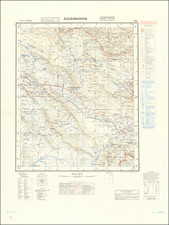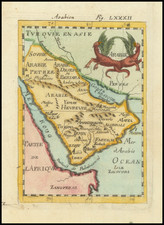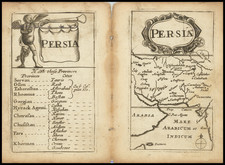A Fascinating, Multifaceted Map of Rasht, Locally-Published by the Islamist Jangal Movement, with Annotations of a British Officer Showing the Relief of the British Consul in 1918. From the Collection of Major General Sir Charles Vere Ferrers Townshend.
Separately-issued, hand-colored lithographed town plan of Rasht, Persia, with three inset maps including a world map, a general map of Persia, and regional map. The map was drawn by Ali Asghar Kermanshahi, identified as the principal of the Ferdowsi School (most likely named for the Persian Poet Abu ʾl-Qasim Firdowsi Tusi). At the top of the map, above the title, are the words "Long Live the Islamic Unity," a slogan of the Jangal movement.
The Jangal Movement of Gilan Province was a rebellion against the monarchist rule of the Qajar central government of Iran. It lasted from 1915 to 1921.
The map is of particular interest, not just as an accomplished separate publication from a noteworthy anti-imperialist Islamist movement, but because its manuscript additions illustrate a specific violent event in the history of the city.
A red-pencil track is drawn from the lower right corner of the map into the center, to the building labeled “CONSUL”. It almost surely shows the route of Captain McCleverty to save the British Consul from being overrun by Jangalis in July of 1918. Additional annotations throughout the map highlight areas related to the British presence in the city.
The Jangal Movement and the Context of Publication
In 1915, Mirza Kuchik Khan, an experienced activist in the Constitutional Revolution, launched the Islamic Jangal movement demanding autonomous status for the province of Gilan, an end to central government corruption, an end to foreign interference in local affairs, and land reform. Near the end of 1917, the Jangalis, organized a "Unity of Islam" committee. By 1920, the Jangalis, who were broadly Shia Muslims, engaged in an uprising in which they demanded regional autonomy and national reforms.
Initially, when commencing the movement, Mirza and his allies formed a union called Ettehad-e-Islam (The Islamic Union or Unity of Islam), hence the words at the top of this map -- "Long Live Islamic Unity". Although in the beginning, they were in conformity over the aims of the movement, eventually the movement began witnessing considerable friction as some members had diverging tendencies toward Ahmad Shah Qajar while others such as Mirza specifically called for an Iranian "Republic."
Not only did Mirza specifically use the term "Republic of Iran," but he had also declared his interest in a "Republic" before the advent of the Communist Party of Iran. This priority let to Khan's removal from his posts in the Persian Socialist Soviet Republic only 17 days after the party's formation. Mirza did not seem to agree with the Party's Marxist ideology, being a devout man of faith, even though many of his allies until the end were members of the Communist Party.
The British did not take Mirza's successes lightly, and sent Captain Edward Noel to assassinate Mirza. The British captain was arrested before he could take any such action and held captive in 1919. Colonel Stokes and General Lionel Dunsterville were further agitated by Mirza's refusal to let British troops pass through Gilan on their way up north, while Mirza had approved and guaranteed Russian troops returning north safe passage. British forces attacked Rasht as a result, and even bombing Mirza's residence using airplanes. An ultimatum was issued to Mirza by the British to surrender.
The Russians joined the British and sent in 20,000 troops to capture Mirza. Many prominent members of the movement such as Haj Ahmad Kasmai, and Dr Talequani Heshmat surrendered, with 270 troops, and the latter was executed despite the immunity that he was granted.
In 1922, the Soviets came to an agreement with the Iranian government to withdraw their troops, especially those assisting the Gilan Republic, and soon after the English declared they would be withdrawing their troops. Ultimately, the Soviets told Mirza that the Soviet Republic, due to changed circumstances, was compromised. As a result, there was an internal conflict in which the leader of the communists, Heidar Amou Oqli, was killed, the "Revolutionary Committee" of the Soviet Republic falling apart, the Jangalis defeated by Reza Khan and Mirza, along with his German companion, freezing to death as they tried to escape Khan's men.
The Relief of the Consulate, July 1918
After dislodging the Jangalis and occupying Rasht in June of 1918, British forces were subjected to a considerable counterattack in late July. The main Jangali force attacked the British base outside the city and was swiftly defeated, however, a secondary force struck in the town, at the British Consulate and other important locations. This prompted a hurried response from the main base, as outlined in this passage from Major-General L. C. Dunsterville’s The Adventures of Dunsterforce (page 203):
At an early hour in the morning Colonel Matthews was notified of the perilous position of the party in the British Consulate, and determined to effect their rescue by the direct road that lay through the narrow streets of the town. It was fortunate that these streets were just wide enough to admit the passage of an armoured car, if cleverly steered, and the relieving party, accompanied by an armoured car, succeeded after severe street-fighting in reaching the Consulate just in time and bringing off Mr. Moir and the garrison.
The relief was effected just as the enemy had succeeded in setting fire to the outer doors of the courtyard, and in a short time the Consulate would have fallen and its occupants would certainly have been massacred. This highly successful task was carried out under the command of Captain McCleverty, of the 1/2 Gurkhas, who conducted the operation with great skill.
The points of interest and the route highlighted on the map in manuscript must have illustrated either Captain McCleverty’s route into the town or his exfiltration of the Consulate party to the main base.
Other Interesting Features of the Map
The map key shows symbols for the following:
-
houses (with names of owners)
-
streets
-
mosques
-
traveler’s accommodations (caravan accommodations)
-
public and private gardens
-
small businesses (including names and the type of business)
-
educational centers (secular school one-room schoolhouse)
-
religious educations centers (madrasa)
-
medical clinics
-
public bath houses
The map includes outline color divisions, showing the political divisions within the town of Rasht. At the bottom left, in the wooded area, the "Territory of Mirza Kuchik Khan" is identified, apparently noting the area controlled by the sympathizers to Mirza Kuchik Khan's moderate Islamist Revolutionary group, the Jangal Movement.
A few other facts gleaned from the map include the location of a cinema in the center square near the Bazaar and Consul and a carriage maker and manufacturer of heavy agricultural equipment near the letters ARM in blue.
The cinema located on this map is part of the second wave of Persian cinema, the first cinemas having been shut down or destroyed by the public after the fall of Mozaffar ad-Din Shah Qajar in 1909. The technology could hardly be suppressed, and cinemas began to open again in 1912 shortly before this map was made.
Provenance: Major General Townshend
The map is from the collection of Charles Townshend. Major General Sir Charles Vere Ferrers Townshend, KCB, DSO (1861 – 1924) was a British Imperial soldier who during the First World War led an overreaching military campaign in Mesopotamia, which led to the defeat and destruction of his command. Known as the Siege of Kut, it lasted from December 1915 to April 1916 and was possibly the worst suffered by the Allies during the war. Forced to surrender, Townshend was held as a prisoner of war on Prinkipo, although he was treated like an esteemed guest, before being released in October 1918.
He would later write the book, When God Made Hell: The British Invasion of Mesopotamia and the Creation of Iraq, 1914-1921.
Rasht
Rasht, is the capital of Gīlān province, north-central Iran. It lies about 15 miles south of the Caspian Sea on a branch of the Sefīd River.
The people of Rasht played a prominent role in instigation and radicalization of the Persian Constitutional Revolution (1905–1907). Rasht is also the birthplace of Mīrzā Kūchak Khān, one of the leading figures of the Constitutional Revolution. His own movement in Gilan, which went by the name of Jangalis, represented a pro-modern and social democratic program for reformation of Muslim rituals and traditions. Mirza established the short-lived Persian Socialist Soviet Republic in 1920, after the defeat of the constitutional forces and in coalition with Iranian communists. The republic had the support of the newly established Russian Red Army. The Soviet Government, after a turn of military and political strategy proposed by Trotsky, withdrew its support and the republic itself was tormented by the inner conflicts between the newly established Iranian Communist Party (1919) and the Jangalis and other factions.










![Arabiae Veteris Typus [Map of Ancient Arabia]](https://storage.googleapis.com/raremaps/img/small/93085.jpg)
![[Cyprus, Holy Land, Syria, Arabia] Tabula Asiae IIII (with) Tabula Asiae III on Verso [Armenia, Georgia etc.]](https://storage.googleapis.com/raremaps/img/small/88877.jpg)
![Turkey in Asia [Including Cyprus]](https://storage.googleapis.com/raremaps/img/small/98704.jpg)

